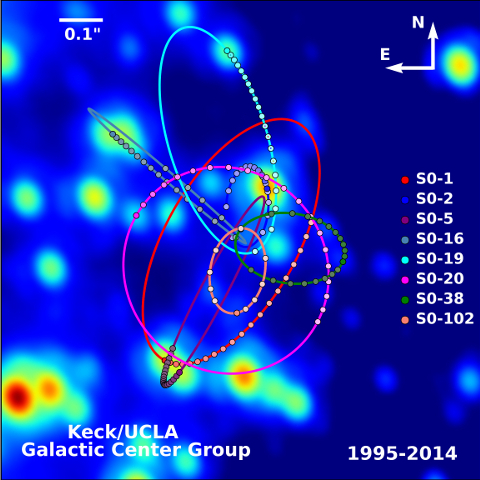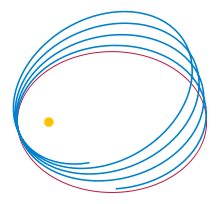
Black Hole Properties
The Galactic Center Group members have been measuring the positions of thousands of stars in the vicinity of the Galactic Center for more than 20 years. This unique data set allowed us to measure directly short-period orbits of stars. In particular, a full phase coverage has been measured for two stars: S0-2 with an orbital period of 15.56 years, and S0-102 with 11.5 years. At the closest approach, S0-2 is only 17 light hours away from the center of the Galaxy, about four times the distance of Neptune from the Sun. From these orbital data, we can determine the mass of the central black hole in our own Galaxy.
The Milky Way Galaxy black hole is the closest example of the supermassive black holes, located only ~25,000 light years away from us. Its mass is estimated to be 4 million times the mass of the sun, which implies that the Schwarzschild radius is about 17 times that of Sun's radius. As a comparison, Mercury's orbit is located at a distance of ∼ 83 solar radii. Because the Galactic Center is the site of the closest supermassive black hole by a factor of 100, it is a unique laboratory for solving some of the greatest mysteries associated with the fundamental physics of supermassive black holes and the role that they play in the fomration and evolution of galaxies. Furthermore, it is the only galactic nucleus in which direct measurements of stellar orbits is possible, with either the current or the next-generation instruments.
Observations of stellar orbits around the Galactic black hole also yields precision measurement of the distance to the Galactic Center, which is important as it affects almost all questions not only of Galactic structure, dynamics and mass, but those of extragalactic distance scales and the value of Hubble's constant as well.
For further reading:
- Ghez et al. 2008 Measuring Distance and Properties of the Milky Way's Central Supermassive Black Hole with Stellar Orbits
- Meyer et al. 2012 The Shortest-Known-Period Star Orbiting Our Galaxy’s Supermassive Black Hole

Testing General Relativity
According to Newton's theory, stellar orbits around the black hole follow elliptical paths. However, Einstein's relativity theory predicts that their orbits advance by a very small amount, tracing altered pattern as shown in the drawing. The difference between the two orbits is most prominent when the stars are at their closest approach with the central black hole.
After two decades of monitoring the orbital motions of stars in the Galaxy's central potential, the Galactic Center Group stands on the precipice of being able to carry out measurements that offer the unique opportunity to test the General Relativity description of gravity, the least tested of the four fundamental forces forces of nature in an unexplored regime. Future measurements of the short-period stars afford the opportunity to probe the structure of space time in a gravitational potential that is 100 times stronger and on a mass scale that is 400,000 times larger than any other existing test, providing tests of GR that many theorists have long anticipated.
The star S0-2 has a highly eccentric 15-year orbit and it will reach its closest approach in 2018, bringing it within 100 AU of the Galactic black hole. This corresponds to about 1000 times the black hole's event horizon (or Schwarzschild radius). During the pericenter passage, the difference between a Newtonian description of the S0-2's orbit and a relativistic one will be significantly larger than the measurement errors, offering an opportunity to test Einstein's General Relativity theory in an unexplored regime.
For further reading:
Many body dynamics in an extreme gravitational potential
Stellar orbits in the Galactic Center have revealed the existence of a supermassive black hole. The movie below right shows a three-dimensional visualization of the stellar orbits in the Galactic center based on data obtained with the W. M. Keck Telescopes between 1995 and 2012. Video details: Copyright the University of Illinois. Available for academic and educational purposes only. Credits integrated within the movie are required for its use.: U. of Illinois NCSA Advanced Visualization Laboratory.
Dynamically relaxed star clusters near a massive black hole are predicted to have a steep increase in stellar density toward the black hole. The red giant stars in the nuclear cluster are likely old enough (1-10 billion years) to have formed such a cusp. However, star counts using AO spectroscopy and imaging have shown that the red giants have a very flat projected surface density profile close to the central black hole.
The orbital dynamics in this extremely dense environment leads to many intriguing scenarios including mergers of stars, tidal disruption, and ejection of stars from the region leading to hyper velocity stars.